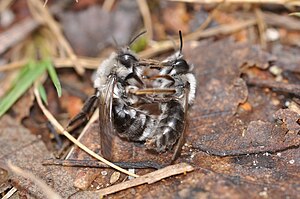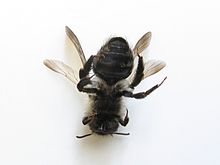Willow sand bee
| Willow sand bee | ||||||||||||
|---|---|---|---|---|---|---|---|---|---|---|---|---|

Willow sand bee ( Andrena vaga ): Male who want to mate is rejected by the female |
||||||||||||
| Systematics | ||||||||||||
|
||||||||||||
| Scientific name | ||||||||||||
| Andrena vaga | ||||||||||||
| Tank , 1799 |
The flounder or willow sand bee ( Andrena vaga ) is a sand bee from the Andrenidae family .
features
The bees are 11 to 14 millimeters long, with the males being slightly smaller than the females. The head and thorax are provided with white-gray hair. The abdomen is black in color and has very little hair. The males have saber-shaped upper jaws and not nodular antennae. They have light legs compared to the females. In the rear pairs of legs of the females, the trochanters (thigh rings) have a lock of hair (flocculus), they have velvety hair ( foveae ) and a well-developed pygidium on the head .
Similar species
- Gray sand bee ( Andrena cineraria ) However, the females of the gray sand bee have a dark transverse band on the back of the chest and the males have dark legs in contrast to the males of the willow sand bee.
Occurrence
The animals occur in temperate Europe north to the Arctic Circle . They live mainly along river valleys on sandy and loamy surfaces, but also on roadsides and in gardens and are often found in places. They fly very early from March to May. In Great Britain she was thought to be missing for 68 years before she was rediscovered in Kent in 2014.
Way of life
In spring, the animals usually come out at the beginning of March, with the animals infested by the Stylops melittae parasite appearing particularly early. This can give the impression that an entire colony has been infected. The males generally hatch a little earlier than the females and fly busily close to the ground in search of females. After mating, the females dig a 25–60 centimeter deep passage in the ground. In suitable places, the animals form colonies with up to several thousand individuals in which each female digs her own nest. There are around 50 of these separate nests per square meter. The nests consist of a corridor which branches off into side corridors at the end of which up to 10 brood cells are gradually created. A pile of sand about five centimeters high is piled up over the entrance. The willow sand bees owe their name to their specialization in the pollen and nectar from willow trees, which they then collect for their brood. They are counted among the leg collectors because they transport the pollen with branched hair on their hind legs. Every time you leave the nest, the entrance is filled with sand. A lump of pollen mixed with nectar is placed in the brood chamber and an egg is laid on it. The cell is then sealed with sand and the construction of another cell begins. In April or May the nest is finally completed and the female dies. The larvae feed on the mixture and are fully grown by the end of spring and spin a cocoon in the brood cell . They remain there motionless until they pupate in midsummer. They overwinter in their cells and do not hatch until the next spring.
Individual evidence
- ↑ Steph Cockroft: Daily Mail: I'll bee back! Rare insect believed to be extinct since 1946 is pictured on Kent coast on May 11, 2014, accessed May 11, 2014
literature
- Heiko Bellmann : bees, wasps, ants. Hymenoptera of Central Europe . Franckh-Kosmos Verlags-GmbH & Co KG, Stuttgart 1995, ISBN 3-440-09690-4 .

